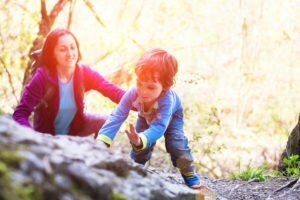There are a number of ways that we can help support children to be successful in school. While academic skills such as literacy and numeracy are imperative to success, it can be challenging for a child (or an adult) to focus on learning when they are struggling to self-regulate. Self-regulation refers to the ability to recognize stress, big or small, positive or negative, and be able to respond to it by managing our actions and emotions. Providing children with self-regulation skills can enhance learning, facilitate prosocial relationships, promote healthy self-confidence, and develop strategies that help children to recognize stressors, and build resilience. And since we know that play is a powerful tool to introduce concepts and build skills, we have compiled a list of three of our favorite self-regulation activities to get you and your little ones practicing these important skills!
Activity #1 – “Listening for the bell”
This activity really gets kids to use their whole body to listen. Try using different bell sounds to dig deeper (was it easier/more difficult to hear one sound over another, what made it easier/harder, talk about how it will be different for each person, etc.).
- Tell your child you are going to play a game that involves listening and hearing.
- Remind them that sitting still and quiet can help listening ears to be activated and that ears hear better especially when there is not a lot of noise around.
- Explain you want them to raise their hand (either hand) until they don’t hear the bell sound anymore.
- Ring a bell.
- See who can hear the sound for the longest amount of time.
- This activity can become a big competition, so be mindful to introduce this as a way to understand how sometimes we listen really well and sometimes it takes a lot of effort. And that however long you did hear the bell, see if you can hear it just a little bit longer than the last time. Building up the length of time that they hear the sound can help show your child that effort counts and that listening can get easier over time.
- Definitely follow up this activity with heaps of specific positive praise about how still their body was or how quiet their voice became when they were listening so they can relate quiet body and quiet voice to active listening.
In this next self-regulation activity, bells can also be used. However, this time we are also incorporating some cooperation skills. Pre-teach children about “bubble spaces” and how it will be important to have calm bodies and calm voices during this activity.
- For this activity, have children sit in a circle.
- Discuss how often times when we think of bells we think of the noise they make. But this time, we are going to concentrate really hard, and try to keep the bell as quiet as possible.
- Explain that they will be passing the bell around the circle, but the trick will be to not let the bell ring. This means, we will have to pass the bell very slowly, and very gently.
- We will also need to have quiet voices and listening ears to hear if the bell rings.
- During this activity, children will have the opportunity to practice focusing by using their senses, regulating their bodies, and cooperating with friends.
- An extension or moderation to this activity can be using a small cup of water to pass around (try not to let it spill!) or a small cup of filled with m&m’s (try not to let them spill, and try not to eat them!) This activity can also be done in pairs, practicing how long you can pass the item back and forth before it rings/spills etc.
 Activity #3 – “DINOSAUR DANCE PARTY at the MUSEUM”
Activity #3 – “DINOSAUR DANCE PARTY at the MUSEUM”
This game is one of those that sounds easy and turns out to be more a bit more challenging than kids think. It’s a great activity to practice self-regulation, handling disappointment and can also get everyone dancing. Because this game can stir up emotions if kiddos get ‘caught’, remind your child that they can say “oh well, maybe next time” if they get out sooner than she wanted to. This game can be played in so many fun ways. We’ve added a fun celebration at the end of this version. Do you have other fun ways to play this game? Share them in the comments below!
- There is a secret dinosaur dance party at the dino exhibit tonight after the museum closes. Dinosaurs from around the world are flocking to the museum to attend. Can they get past the guard to join in the dancing?
- Choose one kiddo to be the museum guard. Everyone else pretends to be a dinosaur trying to get to the dino dance party without being seen by the guard.
- The museum guard closes his eyes, faces away from the crowd, and the dinosaurs come to life.
- As soon as the guard turns around, the dinos freeze.
- If the guard spots any movement, the dinosaur is out and cheers on their fellow dinos.
- Set up a line that the guard stands on. Dinos stand on an opposite line across the room or playing field. Dinos that cross the ending line start the dance party and everyone joins in.
- Spend some time before the game talking about how dinosaurs might walk (big steps, maybe a bit clumsy, etc). Then practice how a dinosaur might walk if she didn’t want to be caught (light footsteps, carefully placing feet, etc.) Let your child move around like a dinosaur to get a feel for it in her body. When you get to the dance party, explore the different ways a dino moves her body when dancing. Laughter and delight will surely fill the room with this fun way to get big movements out of her body.
[divider type=”standard” text=”Go to top” full_width=”no” width=”1/1″ el_position=”first last”]
Text: © Kids In Transition to School 2019
Top image: © Marsia16 | Dreamstime.com; Middle image: © Kids In Transition to School; Bottom image: © Vitalinko| Dreamstime.com




